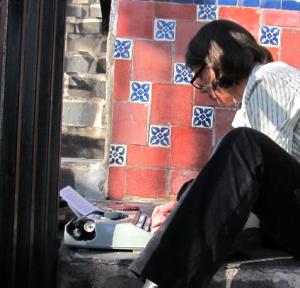“I type poems, the first draft, and many that follow, on my Hermes Rocket or, sometimes, on an Olivetti 22. I am fond of a well-working typewriter in the way I esteem a good piano, as an instrument for making music. I need the muscular effort of pressing keys that lift to imprint a sheet of paper and then fall down again. I draw on the rhythms of my typing to guide the poem, while it decides its beats per line and the size of its stanzas, if there are any. I value having to retype the entire poem with each draft. When the whole piece moves through me afresh with each set of changes, unforeseen shifts occur.”
per line and the size of its stanzas, if there are any. I value having to retype the entire poem with each draft. When the whole piece moves through me afresh with each set of changes, unforeseen shifts occur.”
“Most of all, the typewriter sometimes lets me leave the line I’m typing behind, before I reach its end, so I am chanting, often aloud, one line ahead of myself. It’s something I’ve never been able to do while working on a computer. The temporal alteration of making has something to do with not being able to see the line while I’m actually typing it, because the paper guide covers most of it. This frees my psyche for a mysterious constellating process by which complex images, felt language, and associative leaps become inseparable as they move.”
